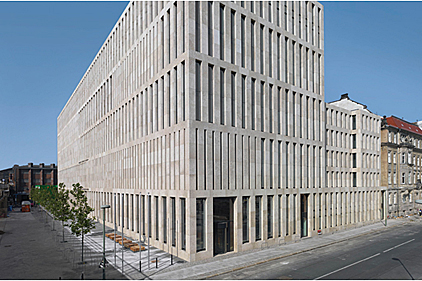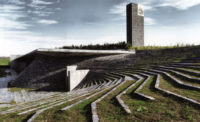This is the 12th edition of a biennial program created by Veronafiere in 1987 as part of the Verona Trade Fair Company’s commitment to the culture of stone. Prizes were presented on September 24, 2011, during Marmomacc in Verona at the Museo di Castelvecchio. The projects were also featured in an exhibit during the trade show.
The jury, which evaluated 27 projects from 13 countries, was comprised of:
• Francesco Dal Co (Editor of
Casabella, Italy)
• Thomas Herzog (Architecture Faculty, University of Munich, Germany)
• Juan José Lahuerta (Architecture Faculty, University of Barcelona, Spain)
• Alessandro Mendini (Editor of Domus, Italy)
• Vincenzo Pavan (Architecture Faculty, University of Ferrara, Italy)
The Award winners follow:
Jacob und Wilhelm Green Zentrum, Berlin, Germany
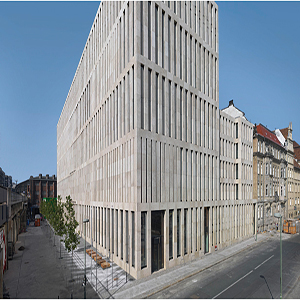
|
| photo by Stefan Müller |
Architect: Max Dudler, Berlin, Germany
Principal Stone Material: Spessart Limestone
Description: The Zentrum was created as the central library and media collection for the Humboldt Universität in Berlin. It has a capacity of 750 students, while offering 2.5 million volumes and 500 computer stations. The clear layout and the organization of internal pathways immediately help to orient visitors, who are free to move both horizontally and vertically.
A large double-height atrium acts as a filter between the interior and exterior, while functioning as a forum for discussion and interaction. From this area, the public can access reading rooms and individual study spaces — areas that are permeable to sight and in constant dialogue with the city. Through Dudler’s approach, the concept of a library is reinvented. This approach does not, however, overlook references to the traditions and materials of ancient libraries, such as the use of stone in the trilithic form of the facade structure and of wood in reading hall flooring and wall coverings.
Jury Comments: Dudler inserts a large compact lithic volume, with extraordinary transparency and openness, into the urban fabric. This is the result of a search for rhythms and proportions in the facades that, at the various levels of the building, include sequences of vertical openings. These openings form a dense network of vertical modules, generating controlled dynamics within the monolithic body of the building. The Spessart limestone that covers the facades, roughened by high pressure water sprays, substantially contributes to the concept of solidity that the building strives to communicate.
Residential Complex in Puente Sarela, Santiago de Compostela, Spain
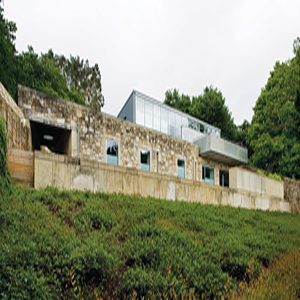
|
| photo by Lluís Casals |
Architect: Victor Lopez Cotelo – Munich, Germany
Principal Stone Material: Local granite
Description: López Cotelo’s firm carried out an attentive redevelopment of a complex of historic structures in Santiago de Compostela, and complemented these with new construction. The project recovered an abandoned tannery and the surrounding area, while respecting and interpreting, through a modern approach, the typical elements of industrial buildings and of the Galician countryside. The old factory’s buildings are grouped together in two nearby complexes: the factory, with its grid of stone pillars, near the river; and the mill and the miller’s house, on higher terrain.
López Cotelo’s extremely respectful intervention was aimed at recuperating the specific character intrinsic to the industrial architecture. In the block of newly built apartments, he used recycled stone in the base, surmounted by a lightweight body made of glass and closed by a galvanized roof. External stone paving underlines the “rural” character of the intervention and connects existing and new.
Jury Comments: The project, built near the historic center of Santiago de Compostela, implements a program for urban residential requalification of preexisting structures, redeveloping the remains of an older building in ruins. López Cotelo manages to avoid the self-referencing nature of several recent architectural works built in the capital of Galicia. He adopts a measured and respectful approach to the existing context, intervening through lightweight structures on the massive granite walls. The project reconnects the old and new buildings to the urban context, through discreet additions of masonry in local granite and a series of measured stone walks that link the various land levels together.
River Terminal and Vistor Center, Linzhi, Tibet, China
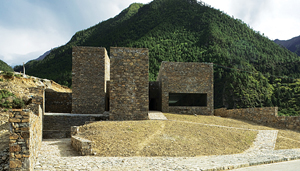
|
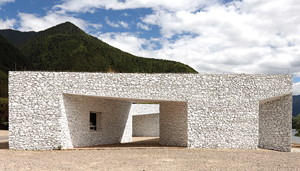
|
| photos by Chen Su |
Architect: Standardarchitecture, Beijing, China
Principal Stone Material: Local stone
Description: The three structures built in Tibet by this firm of young Chinese architects are linked by common characteristics: the complete integration into the surrounding landscape; the use of local materials and of stone collected in the vicinity; and the use of traditional techniques developed by Tibetan craftsmen. The embarcadero, located at the most remote stop on the Yaluntzangpu River, is characterized by a series of ramps that rise up from the water. This fairly spartan structure provides basic services — a ticket office and bathrooms — and can potentially also serve as nighttime shelter for local travelers and tourists who are unable to leave because of bad weather.
The Namchabawa Visitors Centre rises on a slope along the same river, at the foot of a nearly 26,000-foot-high mountain. The 16,145-square-foot building appears as an archaic vision, with a series of walls anchored to the slope and almost devoid of openings. It serves as an information center and support structure for tourists, as well as a meeting point for the local population.
The Niyang River Visitors Centre is a minimal structure with simple volumes marked by deep openings. Sunlight penetrates these openings from different angles and creates constantly changing perceptions. Color transitions highlight the geometric transitions intrinsic to the space.
Jury Comments: Three works support a path that, along the Yaluntzangpu, connects the river with several villages in the Tibetan region of Linzhi. These projects represent the interplay between Standardarchitecture’s architectural “credo” and local native stone culture. The two Visitors Centers and the River Terminal interpret and revitalize traditional stone architecture without bowing to the picturesque. In fact, they elaborate, in a novel way, certain applications derived from local culture, such as highly colored pigments obtained from natural powders and applied directly to the surface of the stone. These projects’ clean lines and measured structural logic are at the root of solid and sustainable architecture integrated with the environment.
Laguna Furnas Research and Monitoring Center, Azores Islands
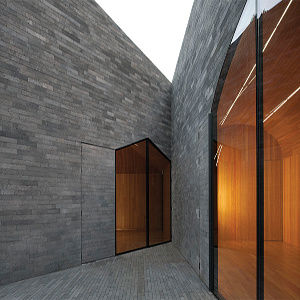
|
|
photo by FG+SG Fernando and Sergio Guerra
|
Architect: Aires Mateus & Associados, Lisbon, Portugal
Principal Stone Material: Local volcanic stone
Description: The project wishes to evoke — through its forms, its simple and compact volumes, as well as its material (local basalt) — the architectural landscape of the Azores. The complex includes small buildings, functioning as studios and lodging, inserted into an extraordinary natural habitat: Laguna Furnas.
The Research Center is characterized by the presence of an intermediate space separating interior and exterior: a patio created by a subtraction of volume, conceived almost as a sculpture; a block of material excavated so that light may enter. The inner facades and the distribution system of the building are revealed within the patio. The building for temporary lodging is compact, symmetrically divided into four units with access from four sides determined by the orientation of the sun’s rays.
The monolithic appearance of the building is achieved using basalt applied to a continuous shell of concrete. An all-wood interior corresponds to an all-stone exterior.
Jury Comments: Two small volumes with simple geometric shapes, set in an extraordinary natural habitat, represent the research and observation sites for the Laguna Furnas Park, a volcanic crater covered in luxurious vegetation. Local basalt is used in homogenous parallel patterns in the external covering, rising from the perimeter walls up onto the roof. These patterns accentuate the distortions of light created by the volumes and make their form ambiguous. Extreme design precision in every minute detail is indispensible in allowing this project to achieve the mysterious power it communicates.
Shiv Temple, Wadeshwar, Maharashtra, India
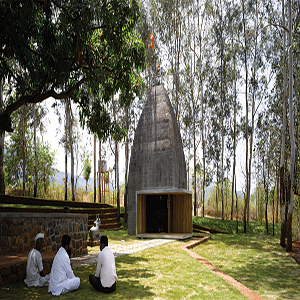
|
| photo by Sameep Padora and Edmund Sumner |
Architect: Sameep Padora & Associates, Mumbai, India
Principal Stone Material: Basalt
Description: The temple rises within a spectacular landscape — on a tree-lined hill overlooking Lake Andhra — from which it radiates a sense of sacred isolation. Upon first glance the Temple of Shiva may look like an ancient temple, fallen into ruin, rediscovered and reclaimed by the present Hindu community. The basalt tower, the shikhara, harks back to traditional construction concepts for sacred buildings. It preserves all of the symbolic elements of temples, but is bare and stripped of decorations and embellishments in order to save on materials and labor.
The only concession to modernity is the steel-covered oak wood portico. Its lowered height invites visitors to bow down as they pass in front of the divinity. Light penetrates from above through an oculus in the heart of the dark garbhagriha (the sanctum sanctorum). The Kalash, made of ashtadhatu, an amalgam of eight different metals (gold, silver, copper, zinc, lead, tin, iron and mercury) is on the top of the roof, making the site a sacred place for Hindus. The basalt, often used in local construction, comes from a quarry located about 60 kilometers from the site and was laid by local masons and stone-cutters.
Jury Comments: Consistently with an approach adopted during the previous edition in 2009, the jury has chosen to present an award to a minimal work, located far from the spotlight, but with a profound sense of spirituality and generosity. The project, in fact, was a gift to the Hindu community from the architect Padora. Workers donated their labor after normal working hours and a quarry supplied the stone. The result, for the local community, is a place of worship perfectly inserted and integrated into the local landscape, where “the trees are the backdrop and the sky is the roof.” It is a work that combines, in an exemplary way, a sophisticated process of intellectual simplification with the crafting talents and resources of the local area.
“Ad Memoriam” Award - Stone Houses, Greece 1962-1978

|
| photo by Aris and Dimitri Konstantinidis |
Architect: Aris Konstantinidis (1913-1993), Athens, Greece
Principal Stone Material: Local Stone
Description: Kostantinidis built his stone houses only when they were compatible with the natural context: where the ground was rock; where there were nearby quarries; and where man had already marked the territory with elements (paths, walls, folds for sheep, etc.) in rough stone blocks or drywall stone. Stone was used by Konstantinidis as it has been used for millennia by builders, farmers and shepherds. Its functionality and size were exploited, as well as its inexpensiveness and potential for reuse.
To design a house, he referred to the criteria of proportionality and functionality that have been followed and respected from time immemorial by the anonymous builders who made the landscape of Greece unique and special. His stone houses seem to grow from the ground like a plant, marvelously integrating themselves into the surrounding landscape.
Jury Comments: The architecture of Aris Konstantinidi, positioned in a delicate equilibrium between the Greek rationalism of the 1930s and 1940s and the vernacular modernism of Pikionis, belongs to that area of architectural thought that uncovers the reason for the formal result of the work in the logic of its construction process. As a result, it is never folkloristic. The use of local stone in his Mediterranean houses -- like those of Anávyssos, Spétses and Egina -- does not recall the form of rural construction. Rather, it uses the construction wisdom that produced them, entrusting composition of spaces and rhythms to a philosophy close to that of Mies van der Rohe. Konstantinidis gives us a lesson on tectonics that forces us to reflect on the richness and complexity of simple forms.
Vernacular Architecture Prize — Svaneti Tower Houses — Georgia, 12th Century
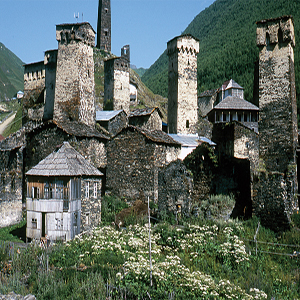
|
| photo by Fondazione Sella |
Principal Stone Material: Local stone
Description: Svaneti, a region known in antiquity as Colchis and famous for the legend of the Golden Fleece, is located on the slopes of the high mountain range of the Great Caucasus. Difficult to access, the region was protected from invasions, making it possible to preserve extraordinary medieval villages (including Mestia, Ushguli and Latali), with their typical tower houses.
The main characteristic of these houses is their tower, with a square footprint (15 x 15 feet) and a truncated pyramid shape (about 25 yards tall). The tower generally includes four stories, only the last of which has narrow slits for windows. Generally, the traditional residence of a local family was a large two-story structure. The ground floor was used as a stable, with the next floor serving as hayloft and residential zone. Typically, the tower is attached to the house. Svane family groups could include as many as 100 members.
Jury Comments: The groups of tower houses that characterize the settlements of the Upper Svaneti, located into the extraordinary mountain landscape of the Caucasus, are a unique example of vernacular architecture in stone. Their dual function -- as residences and for defense from invading armies — has ancient origins. It is at the start of the 12th century, at the time of the Mongol invasion, that this type of building became common in communities of the Inguri Valley. The antiquity of the buildings and their superb landscape quality were the reasons for their inclusion in the Unesco World Heritage List. This Award intends to further explore and examine the originality of this residential and construction system in relationship to its site.
